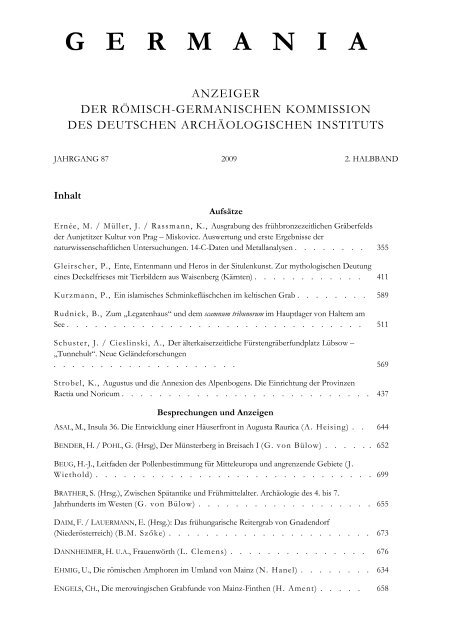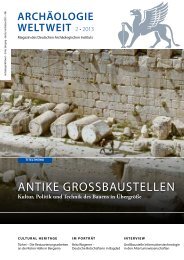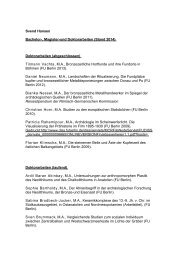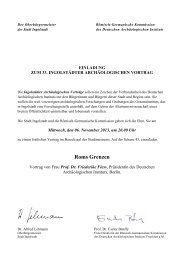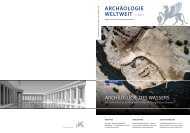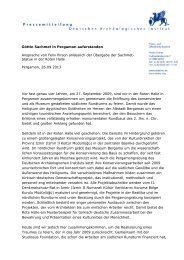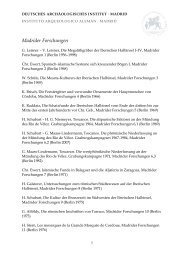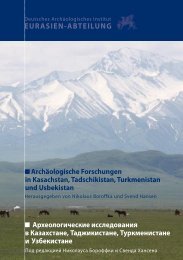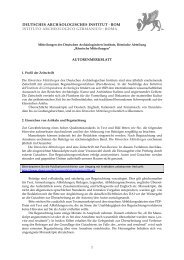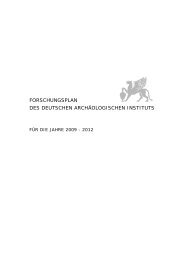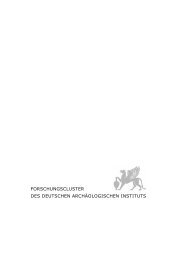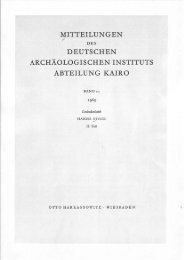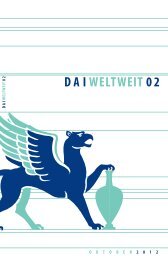und Zusammenfassungen als PDF - Deutsches Archäologisches ...
und Zusammenfassungen als PDF - Deutsches Archäologisches ...
und Zusammenfassungen als PDF - Deutsches Archäologisches ...
Erfolgreiche ePaper selbst erstellen
Machen Sie aus Ihren PDF Publikationen ein blätterbares Flipbook mit unserer einzigartigen Google optimierten e-Paper Software.
G E R M A N I A<br />
ANZEIGER<br />
DER RÖMISCH-GERMANISCHEN KOMMISSION<br />
DES DEUTSCHEN ARCHÄOLOGISCHEN INSTITUTS<br />
JAHRGANG 87 2009 2. HALBBAND<br />
Inhalt<br />
Aufsätze<br />
Ernée, M. / Müller, J. / Rassmann, K., Ausgrabung des frühbronzezeitlichen Gräberfelds<br />
der Aunjetitzer Kultur von Prag – Miskovice. Auswertung <strong>und</strong> erste Ergebnisse der<br />
naturwissenschaftlichen Untersuchungen. 14-C-Daten <strong>und</strong> Metallanalysen . . . . . . . . 355<br />
Gleirscher, P., Ente, Entenmann <strong>und</strong> Heros in der Situlenkunst. Zur mythologischen Deutung<br />
eines Deckelfrieses mit Tierbildern aus Waisenberg (Kärnten) . . . . . . . . . . . . 411<br />
Kurzmann, P., Ein islamisches Schminkefläschchen im keltischen Grab . . . . . . . . 589<br />
Rudnick, B., Zum „Legatenhaus“ <strong>und</strong> dem scamnum tribunorum im Hauptlager von Haltern am<br />
See . . . . . . . . . . . . . . . . . . . . . . . . . . . . . . . . 511<br />
Schuster, J. / Cieslinski, A., Der älterkaiserzeitliche Fürstengräberf<strong>und</strong>platz Lübsow –<br />
„Tunnehult“. Neue Geländeforschungen<br />
. . . . . . . . . . . . . . . . . . . . 569<br />
Strobel, K., Augustus <strong>und</strong> die Annexion des Alpenbogens. Die Einrichtung der Provinzen<br />
Raetia <strong>und</strong> Noricum . . . . . . . . . . . . . . . . . . . . . . . . . . . 437<br />
Besprechungen <strong>und</strong> Anzeigen<br />
ASAL, M., Insula 36. Die Entwicklung einer Häuserfront in Augusta Raurica (A. Heising) . . 644<br />
BENDER, H. / POHL, G. (Hrsg), Der Münsterberg in Breisach I (G. von Bülow) . . . . . . 652<br />
BEUG, H.-J., Leitfaden der Pollenbestimmung für Mitteleuropa <strong>und</strong> angrenzende Gebiete (J.<br />
Wiethold) . . . . . . . . . . . . . . . . . . . . . . . . . . . . . . 699<br />
BRATHER, S. (Hrsg.), Zwischen Spätantike <strong>und</strong> Frühmittelalter. Archäologie des 4. bis 7.<br />
Jahrh<strong>und</strong>erts im Westen (G. von Bülow) . . . . . . . . . . . . . . . . . . . 655<br />
DAIM, F. / LAUERMANN, E. (Hrsg.): Das frühungarische Reitergrab von Gnadendorf<br />
(Niederösterreich) (B.M. Szőke) . . . . . . . . . . . . . . . . . . . . . . 673<br />
DANNHEIMER, H. U.A., Frauenwörth (L. Clemens) . . . . . . . . . . . . . . . 676<br />
EHMIG, U., Die römischen Amphoren im Umland von Mainz (N. Hanel) . . . . . . . . 634<br />
ENGELS, CH., Die merowingischen Grabf<strong>und</strong>e von Mainz-Finthen (H. Ament) . . . . . 658
GERMANIA 87, 2, 2009<br />
GARCÍA-BELLIDO, M. P. (coord.), Los Campamentos Romanos en Hispania (27 a.C. – 192 d.C.)<br />
(F. Kemmers) . . . . . . . . . . . . . . . . . . . . . . . . . . . . 623<br />
GRÜNEWALD, M. / HAHN, E., unter Mitarbeit von VOGT, K., Zwischen Varusschlacht <strong>und</strong><br />
Völkerwanderung. Die römerzeitlichen Gräberf<strong>und</strong>e aus Worms <strong>und</strong> Rheinhessen im Museum der<br />
Stadt Worms im Andreasstift (H. Ament) . . . . . . . . . . . . . . . . . . 638<br />
HULD-ZETSCHE, I., Der Mithraskult in Mainz <strong>und</strong> das Mithräum am Ballplatz (R. Wiegels) . . 641<br />
KIRILOV, T., Die Stadt des Frühmittelalters in Ost <strong>und</strong> West (H. Steuer) . . . . . . . . . 669<br />
KRAUS, J., Die soziale Differenzierung der östlichen Aunjetitzer Kultur in den Bronzezeitstufen A2<br />
<strong>und</strong> A3 (B. Zich) . . . . . . . . . . . . . . . . . . . . . . . . . . . 603<br />
KYTLIKOVÁ, O. (†), Jungbronzezeitliche Hortf<strong>und</strong>e in Böhmen (M. Novotná) . . . . . 607<br />
LEIFELD, H., Endlatène- <strong>und</strong> älterkaiserzeitliche Fibeln aus Gräbern des Trierer Landes (A.<br />
Böhme) . . . . . . . . . . . . . . . . . . . . . . . . . . . . . . 616<br />
MANTE, G., Die deutschsprachige prähistorische Archäologie (M.K.H. Eggert) . . . . . 690<br />
MELZER, W. / CAPELLE, T. (Hrsg.), Bleibergbau <strong>und</strong> Bleiverarbeitung während der römischen<br />
Kaiserzeit im rechtsrheinischen Barbaricum (M. Erdrich) . . . . . . . . . . . . . 626<br />
PANKAU, C., Die Besiedlungsgeschichte des Brenz-Kocher-Tales (östliche Schwäbische Alb) vom<br />
Neolithikum bis zur Latènezeit (J. E. Fries) . . . . . . . . . . . . . . . . . . 680<br />
PETER-RÖCHER, H., Gewalt <strong>und</strong> Krieg im prähistorischen Europa (U. Veit) . . . . . . . 684<br />
POSSELT, M. / ZICKGRAF, B. / DOBIAT, C. (Hrsg.), Geophysik <strong>und</strong> Ausgrabung – Einsatz <strong>und</strong><br />
Auswertung zerstörungsfreier Prospektion in der Archäologie<br />
(C. Mischka) . . . . . . . . . . . . . . . . . . . . . . . . . . . . 695<br />
ROSE, H., Die römischen Terrakottamasken in den Nordwestprovinzen (K. Roth-Rubi) . . . . 631<br />
ROYMANS, N., Ethnic Identity and Imperial Power. The Batavians in the Early Roman Empire (J.<br />
Schulze-Forster) . . . . . . . . . . . . . . . . . . . . . . . . . . . 619<br />
SABATINI, S., House Urns. A European Late Bronze Age Trans-cultural Phenomenon (J.<br />
Kneisel) . . . . . . . . . . . . . . . . . . . . . . . . . . . . . . 611<br />
SCHÄFER, A., Tempel <strong>und</strong> Kult in Sarmizegetusa (G. von Bülow) . . . . . . . . . . 647<br />
SCHESCHKEWITZ, J., Das spätrömische <strong>und</strong> angelsächsische Gräberfeld von Wasperton,<br />
Warwickshire (B. Brugmann) . . . . . . . . . . . . . . . . . . . . . . . 660<br />
SLAWISCH, A., Die Grabsteine der römischen Provinz Thracia (G. von Bülow) . . . . . 649<br />
URBAŃCZYK, P., Herrschaft <strong>und</strong> Politik im Frühen Mittelalter (S. Brather) . . . . . . . 666<br />
VERSLYPE, L.(Hrsg.), Villes et campagnes en Neustrie. Sociétés - Économies - Territoires –<br />
Christianisation (H. Ament) . . . . . . . . . . . . . . . . . . . . . . . 664<br />
ZELLER, G., Das fränkische Gräberfeld von Badenheim (H. Ament) . . . . . . . . . 658<br />
Hinweise für Publikationen der Römisch-Germanischen Kommission . . . . . . . . . . 703<br />
2
GERMANIA 87, 2, 2009<br />
Resümees<br />
Ernée, M. / Müller, J. / Rassmann, K., Ausgrabung des frühbronzezeitlichen<br />
Gräberfelds der Aunjetitzer Kultur von Prag – Miskovice<br />
In Prag - Miškovice wurde zwischen 1999 <strong>und</strong> 2001 ein Gräberfeld der Aunjetitzer Kultur (AK) mit<br />
insgesamt 43 Gräbern entdeckt. Die 14 C-Daten fallen in den gesamten Verlauf der mitteleuropäischen<br />
Frühbronzezeit – von der "Protoaunjetitzer" Phase bis zur "nachklassischen" Phase der AK. Schwerpunkt<br />
der Bestattungsaktivitäten liegt zwischen 2000–1750 BC (Klassische AK). Archäometallurgische <strong>und</strong><br />
archäologische Untersuchungen des F<strong>und</strong>materi<strong>als</strong> (Meißel, Beil, Dolchklingen Nadeln, reicher<br />
Bernsteinschmuck, Meeresmuscheln usw.) spiegeln kulturelle Beziehungen von der Ostsee bis zum<br />
Alpenraum. Es ist anzunehmen, dass die Bevölkerung Mittelböhmens während der Klassischen AK durch<br />
die exzellente verkehrsgeographische Lage vom Austausch von Metall <strong>und</strong> Bernstein profitierte.<br />
Ernée, M. / Müller, J. / Rassmann, K., Excavation of the Early Bronze Age<br />
Cemetery of the Aunjetitz Culture at Prague – Miskovice<br />
In Prague- Miškovicea, a cemetery of the Aunjetitz culture (AK) with a total of 43 graves was excavated<br />
between 1999 <strong>und</strong> 2001. The C 14 dates range across the entire course of Central Europe’s Early Bronze<br />
Age – from the proto-Aunjetitz phase to the “post-classical” phase of the AK. The high point of the<br />
mortuary activities occurred between 2000 and 1750 BC (classical AK). Archaeometallurgical and<br />
archaeological studies of the finds (chisel, axe, dagger blades, pins, rich amber ornaments, sea shells, etc.)<br />
reflect cultural relationships ranging from the Baltic to the Alpine region. It is to be assumed that the<br />
people of Central Bohemia during the classical AK, due to their excellent geographic location in regard to<br />
traffic routes, profited from trade in met<strong>als</strong> and amber.<br />
Ernée, M. / Müller, J. / Rassmann, K., Fouille de la nécropole du Bronze ancien de<br />
Prag-Miškovice (culture d’Unetice)<br />
C.M.-S.<br />
Entre 1999 et 2001, on a découvert à Prag-Miškovice une nécropole de la culture d’Unetice (AK =<br />
Aunjetitzer Kultur) comprenant au total 43 tombes. Les dates 14 C occupent toute la séquence Bronze<br />
ancien de l’Europe centrale, de la phase « Proto-Unetice » à la phase « post-classique » de l’Unetice. Les<br />
activitités funéraires se situent principalement entre 2000 et 1750 BC (Unetice classique). Les examens<br />
archéologiques et métallurgiques du matériel (ciseaux, haches, lames de poignards, épingles, riches bijoux<br />
d’ambre, coquillages de mer etc.) révèlent des contacts culturels de la Baltique aux Alpes. Il est probable<br />
que la population de la Bohême centrale ait profité de son excellente position dans le réseau des voies<br />
d’échanges des métaux et de l’ambre durant la phase classique de l’Unetice.<br />
Y.G.<br />
3
GERMANIA 87, 2, 2009<br />
Gleirscher, P., Ente, Entenmann <strong>und</strong> Heros in der Situlenkunst. Zur mythologischen<br />
Deutung eines Deckelfrieses mit Tierbildern aus Waisenberg (Kärnten)<br />
Im zweiten Prunkgrabhügel von Waisenberg (Kärnten) kam unter anderem ein im Stil der Situlenkunst<br />
verzierter bronzener Deckel mit einem Tierfries ans Licht. Sieben Tiere bewegen sich gegen den<br />
Uhrzeigersinn. Vier Hirsche scheinen von einem Löwen <strong>und</strong> einer Sphinx bedroht zu sein. Dazu kommt<br />
ein übergroß dargestellter Wasservogel, vermutlich eine Ente. Ihr kommt für das Verständnis des<br />
Tierfrieses die entscheidende Bedeutung zu, weil sich in vergleichbaren Friesen im Bereich der Veneter<br />
sowie in Unterkrain stattdessen ein geflügelter Mann, ein Krieger bzw. ein Mann finden. Es wird<br />
vorgeschlagen, in der Darstellung einen Mythos vom Typus des Drachentöters bzw. Kulturbringers zu<br />
sehen.<br />
Gleirscher, P., Duck, Duck-Man and Hero in Situla Art. On the Mythological Interpretation of<br />
a Lid-Frieze with Animal Figures from Waisenberg (Kärnten)<br />
In the second high-status grave mo<strong>und</strong> at Waisenberg (Kärnten), there was discovered, among other<br />
objects, a bronze lid decorated with an animal frieze in the style of Situla Art. Seven anim<strong>als</strong> move in a<br />
counter-clockwise direction. Four stags appear to be threatened by a lion and a sphinx. In addition, an<br />
oversized water fowl appears, probably a duck. This latter figure is of crucial importance to an<br />
<strong>und</strong>erstanding of the animal frieze since, in comparable friezes from the Venetic area as well in<br />
Unterkrain, a winged man, warrior or male figure is fo<strong>und</strong> instead. It is proposed that the scene may<br />
illustrate a myth of the dragon-slayer or culture-bringer type.<br />
C.M.-S.<br />
Gleirscher, P., Canard, homme-oiseau et héros dans l’art des situles. Au sujet de<br />
l'interprétation d'une frise d'animaux sur un couvercle de Waisenberg (Kärnten)<br />
Le deuxième tumulus princier de Waisenberg (Kärnten) a livré entre autres un couvercle de bronze décoré<br />
d’une frise d’animaux dans le style de l’art des situles. Sept animaux se déplacent en sens inverse des<br />
aiguilles d’une montre. Quatre cerfs semblent menacés par un lion et un sphinx. S’y ajoute un très grand<br />
oiseau aquatique, probablement un canard. Ce dernier joue un rôle clé dans la compréhension de la frise,<br />
car il cède sa place à un homme ailé, un guerrier ou un homme, dans des frises comparables de la région<br />
des Vénètes et d’Unterkrain. On propose d’y voir un mythe du type « tueur de dragons » ou « porteur de la<br />
civilisation ».<br />
Y.G.<br />
4
GERMANIA 87, 2, 2009<br />
Strobel, K., Augustus <strong>und</strong> die Annexion des Alpenbogens. Die Einrichtung der Provinzen<br />
Raetia <strong>und</strong> Noricum<br />
Eine Zäsur in der Geschichte des Alpenraumes bildet seine Annexion unter der Regierung des Augustus,<br />
in deren Verlauf die Vorgänge der Jahre 16 <strong>und</strong> 15 v. Chr. für Noricum <strong>und</strong> Raetien zu<br />
Schüsselereignissen wurden. Umstritten blieb in der Forschung die Frage der Provinzwerdung beider<br />
Regionen. Der Beitrag untersucht die römische Politik <strong>und</strong> schrittweise Annexion seit caesarischer Zeit,<br />
sodann die Völkerliste des Tropaeum Alpium <strong>und</strong> den Verlauf der Operationen 16/15 v. Chr. Schließlich<br />
wird die Einrichtung der Provinzen in den unmittelbaren Zusammenhang der Annexion gestellt <strong>und</strong> ihre<br />
erste Ausgestaltung untersucht. Ein Anhang behandelt P. Quinctilius Varus <strong>als</strong> Kommandeur im<br />
Alpenkrieg.<br />
Strobel, K., The Annexation of the Alpine Region and the Creation of the<br />
Provinces of Raetia <strong>und</strong> Noricum<br />
A caesura in the history of the Alpine region is its annexation during the reign of Augustus, in the course<br />
of which the incidents of the years 16 and 15 BC were key events for Noricum and Raetia. The question<br />
of the acquisition of provincial status remains a controversial topic in the research literature. The present<br />
report examines the Roman policy and step-by-step annexation since caesarean times, as well as the list of<br />
peoples from the Tropaeum Alpium and the course of operations in 16/15 BC. Finally, the creation of the<br />
provinces is presented in the immediate context of the annexation and their initial organization is<br />
investigated. An addendum de<strong>als</strong> with P. Quinctilius Varus as Commander of the Alpine War.<br />
C.M.-S.<br />
Strobel, K., L’annexion de l’arc alpin et l’instauration des provinces de Rhétie et de Noricum<br />
L’annexion de l’arc alpin sous le règne d’Auguste, au cours de laquelle les événements des années 16 et 15<br />
av. J.-C. furent décisifs pour le Noricum et la Rhétie, marque une césure dans son histoire. La mutation de<br />
ces deux régions en provinces romaines resta fort discutée dans le monde de la recherche. Cet article<br />
examine la politique romaine et l’annexion progressive depuis l’époque de César, puis la liste des peuples<br />
figurant sur le Tropaeum Alpium ainsi que le déroulement des opérations des années 16/15 av. J.-C. Enfin,<br />
on place l’instauration des provinces dans le contexte même de l’annexion et on les examine sous leur<br />
première forme. Une annexe traite de P. Quinctilius Varus en tant que commandant dans la conquête des<br />
Alpes.<br />
Y.G.<br />
5
GERMANIA 87, 2, 2009<br />
Rudnick, B., Zum „Legatenhaus“ <strong>und</strong> dem scamnum tribunorum im Hauptlager von Haltern<br />
am See<br />
Im augusteischen Hauptlager von Haltern wurde bislang von einem scamnum tribunorum mit sechs<br />
gleichförmigen Gebäuden ausgegangen. Die Revision der Grabungsdokumentation sowie Parallelen aus<br />
Oberaden <strong>und</strong> Anreppen lassen die ursprünglich <strong>als</strong> Reste von zwei Tribunenbauten gedeuteten Strukturen<br />
eher <strong>als</strong> nördlichen Abschluss eines großen Peristylhofes mit zentraler Exedra deuten. Die prominente Lage<br />
unmittelbar westlich des Praetoriums lässt einen Kontext beider Bauteile erkennen, die zusammen eine Fläche<br />
von 3412 m 2 einnehmen. Eine erste Bauphase geht auf die Gründungszeit des Hauptlagers zurück. Ein<br />
Umbau könnte im Kontext der Erweiterung des Hauptlagers wohl zu Beginn der Statthalterschaft des P.<br />
Quinctilius Varus erfolgt sein.<br />
Rudnick, B., On the „Legate’s House“and the scamnum tribunorum in the Main<br />
Camp at Haltern am See<br />
In the main Augustan camp at Haltern, up to now, a scamnum tribunorum with six identically-shaped<br />
buildings was assumed. Review of the excavation documents, as well as parallels from Oberaden and<br />
Anreppen, allow the structures originally identified as the remains of two tribune buildings to be<br />
identified, instead, as the northern termination of a large peristyle courtyard with central exedra. The<br />
prominent location, immediately west of the Praetorium, allows the context of both building elements to<br />
be recognized, which together occupy an area of 3412 m². An initial building phase goes back to the<br />
fo<strong>und</strong>ing period of the main camp. Rebuilding could have taken place in the context of expanding the<br />
main camp at the start of the governorship of P. Quinctilius Varus.<br />
C.M.-S.<br />
Rudnick, B., A propos du « bâtiment du légat » et du scamnum tribunorum dans le camp<br />
principal de Haltern am See<br />
On envisageait jusqu’ici pour le camp augustéen principal de Haltern un scamnum tribunorum constitué de<br />
six bâtiments identiques. La révision de la documentation des fouilles et les comparaisons faites avec<br />
Oberaden et Anreppen permettent de voir dans les structures interprétées jadis comme des vestiges de<br />
maisons occupées par des tribuns la limite septentrionale d’une grande cour à péristyle et exèdre centrale.<br />
Leur situation exceptionnelle juste à l’ouest du prétoire permet de restituer le contexte de ces deux<br />
bâtiments qui recouvrent ensemble une surface de 3412 m 2 . Une première phase de construction remonte<br />
à la fondation du camp principal. Une transformation a eu lieu peut-être lors de l’agrandissement de ce<br />
camp au début du gouvernat de P. Quinctilius Varus.<br />
Y.G.<br />
6
GERMANIA 87, 2, 2009<br />
Schuster, J. / Cieslinski, A., Der älterkaiserzeitliche Fürstengräberf<strong>und</strong>platz Lübsow –<br />
„Tunnehult“. Neue Geländeforschungen<br />
2006 wurden neue Ausgrabungen auf dem seit 1925 bekannten F<strong>und</strong>platz mit Prunkbestattungen bei<br />
Lübsow, Kr. Greifenberg (heute Lubieszewo, pow. Gryfice, Polen) durchgeführt. Das deutsch-polnische<br />
Kooperationsvorhaben betraf das seit der Erstöffnung durch ortsansässige Bauern unberührte Hügelgrab<br />
Tunnehult 1. Es wurden Informationen zu Aufbau, Ausmaßen <strong>und</strong> Konstruktion von Hügel <strong>und</strong><br />
Grabkammer gewonnen; darüber hinaus gelang die Bergung weiterer F<strong>und</strong>e, welche die<br />
Inventarzusammensetzung in neuem Licht erscheinen lassen. Zu ihnen zählen Fragmente eines bemalten<br />
Glasgefäßes, silbervergoldete Applikationen wohl eines Prunkgürtels <strong>und</strong> in der Germania magna unikate<br />
Einlagen aus Malachit. Für das Grab Tunnehult 3 konnte mit dem F<strong>und</strong> einer Bronzefibel ein<br />
Datierungsansatz gewonnen werden.<br />
Schuster, J. / Cieslinski, A., The Late Imperial Princely Burial Site of Lübsow –<br />
„Tunnehult“. New Fieldwork<br />
In 2006, new excavations were conducted at a site with rich buri<strong>als</strong>, known since 1925, near Lübsow,<br />
Greifenberg District (today’s Lubieszewo, Gryfice District, Poland). The German-Polish cooperative<br />
project focused on the barrow grave Tunnehult 1, which has been <strong>und</strong>isturbed since its first opening by<br />
local farmers. Information concerning the structure, dimensions and construction of the mo<strong>und</strong> and grave<br />
chamber was collected; in addition, additional finds were made, which shed new light on the composition<br />
of the inventory. Among these are fragments of a painted glass container, silver-gilt applications - most<br />
probably from a decorated belt – and, unique in Germania magna, an inlay made of malachite. For the<br />
Tunnehult 3 grave, with the find of a bronze fibula, a dating factor could be obtained.<br />
C.M.-S.<br />
Schuster, J. / Cieslinski, A., Le site de sépultures princières du Haut-Empire de Lübsow-<br />
« Tunnehult ». Nouvelles recherches sur le terrain<br />
En 2006, de nouvelles fouilles furent menées sur le site de sépultures princières situé près de Lübsow, Kr.<br />
Greifenberg (aujourd’hui Lubieszewo, pow. Gryfice, Pologne) et connu depuis 1925. Le projet de<br />
coopération allemano-polonais concernait le tumulus Tunnehult 1 resté intact depuis sa première violation<br />
par des paysans locaux. On y a récolté des informations touchant à la composition, aux dimensions et à la<br />
construction du tumulus et de la chambre funéraire. En furent en outre extraits des objets qui jettent un<br />
nouvel éclairage sur la composition du mobilier funéraire et parmi lesquels figurent des fragments de vases<br />
en verre peint, des appliques en argent dorées, appartenant vraisemblablement à une ceinture d’apparat, et<br />
des incrustations de malachite uniques en Germania magna. La découverte d’une fibule en bronze dans le<br />
tumulus Tunnehult 3 livre un élément de datation.<br />
Y.G.<br />
7
GERMANIA 87, 2, 2009<br />
Kurzmann, P., Ein islamisches Schminkefläschchen im keltischen Grab<br />
Das von Oskar Fraas 1877 in einem keltischen Hügelgrab bei Ludwigsburg gef<strong>und</strong>ene Glasfläschchen<br />
wurde <strong>als</strong> islamisches Glas des 14.-15. Jahrh<strong>und</strong>erts für schwarze Augenschminke der muslimāt<br />
identifiziert. Wie es ins Abendland <strong>und</strong> in das Keltengrab gelangte, konnte nicht geklärt werden. Zwei<br />
Vergleichsf<strong>und</strong>e in London <strong>und</strong> Mainz aus dem Kunsthandel wurden wegen ihrer großen Ähnlichkeit<br />
sicherlich in derselben Werkstatt, wohl in Ägypten, hergestellt. Analyseergebnisse für islamische Gläser<br />
des 14./15. Jahrh<strong>und</strong>erts werden erstm<strong>als</strong> publiziert <strong>und</strong> schließen sich an die vielfach publizierten<br />
Ergebnisse aus früherer islamischer Zeit an. Es handelt sich um die üblichen Halophytenaschegläser. Die<br />
weißen Girlanden bestehen aus mit Zinndioxid getrübtem Bleiglas.<br />
Kurzmann, P., An Islamic Cosmetic Bottle in a Celtic Grave<br />
The small glass bottle fo<strong>und</strong> by Oskar Fraas in 1887 in a Celtic barrow grave near Ludwigsburg has been<br />
identified as Islamic glass of the 14 th -15 th century, a container for the black eye makeup typical of the<br />
Muslim world. How the bottle came to Europe and into the Celtic grave cannot be explained. Two<br />
comparable finds in London and Mainz, from the antiquities trade, show great similarity and were<br />
certainly made in the same workshop, most likely in Egypt. Results of an analysis of Islamic glass of the<br />
14 th /15 th centuries are published for the first time and follow the frequently published results from earlier<br />
Islamic periods. They deal with the common halophyte ash glass. The white garlands are made of lead<br />
glass, clouded by zinc oxide.<br />
C.M.-S.<br />
Kurzmann, P., Un flacon à fard islamique dans une tombe celte<br />
Le flacon de verre découvert en 1877 par Oskar Fraas dans un tumulus celte près de Ludwigsburg s’est<br />
révélé être un pot à fard noir en verre d’origine islamique datant des 14 e / 15 e siècles av. J.-C. pour le<br />
maquillage des yeux des muslimāt (musulmanes). Son arrivée en Occident et son dépôt dans un tumulus<br />
celte n’ont pas pu être élucidés. Vu leur grande ressemblance, deux objets similaires de Londres et de<br />
Mayence, acquis sur le marché de l’art, furent certainement exécutés dans le même atelier,<br />
vraisemblablement en Egypte. Les résultats d’analyses concernant des verres islamiques des 14 e /15 e siècles<br />
sont publiés pour la première fois et rejoignent les résultats publiés à plusieurs reprises pour des périodes<br />
islamiques antérieures. Il s’agit des verres habituels à base de cendres de plantes halophytes. Les guirlandes<br />
blanches sont en verre au plomb rendu opaque par du dioxyde d’étain.<br />
Y.G.<br />
8


